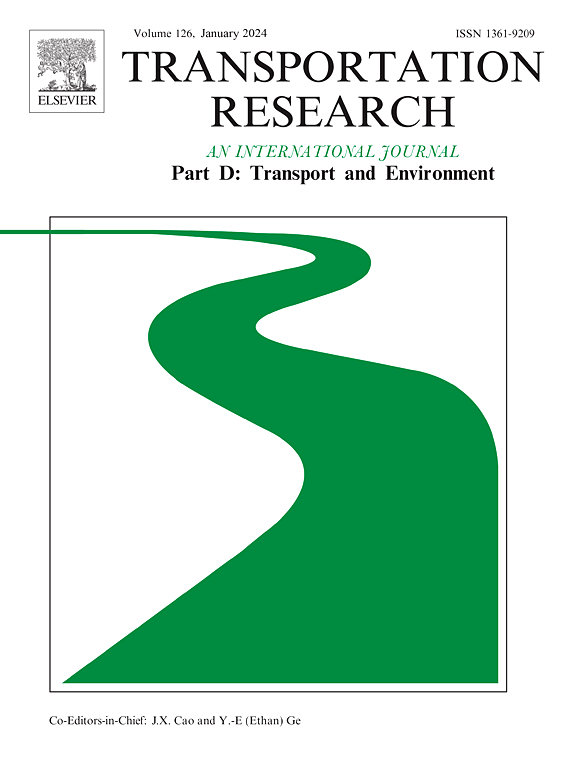香港低噪音路面的声老化:回归模型及机制研究
IF 7.3
1区 工程技术
Q1 ENVIRONMENTAL STUDIES
Transportation Research Part D-transport and Environment
Pub Date : 2025-05-08
DOI:10.1016/j.trd.2025.104793
引用次数: 0
摘要
本研究旨在模拟低噪声路面的声老化行为,探讨其声老化机制。选择了香港常用的三种LNPs:聚合物改性摩擦层(PMFC)、聚合物改性石胶泥沥青(PMSMA)和碎橡胶改性石胶泥沥青(CRSMA)。通过噪声水平、噪声谱以及交通和气候相关数据分析了声老化机制。建立了回归模型来预测声老化行为。确定了影响LNPs声老化的关键因素。结果表明,PMFC6产生的初始TRN最低,但声老化速度最快,CRSMA6在5年以上的降噪耐久性中表现优异,其次是PMSMA6。巷道位置和施工场地位置对声老化率有影响。幂函数和对数回归模型均能有效地描述PMFC和PMSMA路面的声老化。胎路噪声(TRN)主要受道路年龄、LNP类型和试验速度的影响。本文章由计算机程序翻译,如有差异,请以英文原文为准。
Acoustic aging of low-noise pavements in Hong Kong: Regression modelling and mechanism investigation
This study aims to model the acoustic aging behavior of low-noise pavements (LNPs) and investigate their acoustic aging mechanisms. Three LNPs commonly used in Hong Kong were selected: polymer-modified friction course (PMFC), polymer-modified stone mastic asphalt (PMSMA), and crumbed rubber-modified stone mastic asphalt (CRSMA). Acoustic aging mechanisms were analyzed by noise levels, noise spectra, and traffic- and climate-related data. Regression models were developed to predict acoustic aging behaviors. Key factors affecting the acoustic aging of LNPs were identified. Results indicated that PMFC6 generated the lowest initial TRN but experienced the fastest acoustic aging rate, while CRSMA6 demonstrated superior noise-reduction durability over 5 years, followed by PMSMA6. Lane positions and construction site locations had influences on acoustic aging rates. Both power function and logarithmic regression models could effectively describe the acoustic aging of PMFC and PMSMA pavements. Tire-road noise (TRN) was primarily influenced by road age, LNP type, and test speed.
求助全文
通过发布文献求助,成功后即可免费获取论文全文。
去求助
来源期刊
CiteScore
14.40
自引率
9.20%
发文量
314
审稿时长
39 days
期刊介绍:
Transportation Research Part D: Transport and Environment focuses on original research exploring the environmental impacts of transportation, policy responses to these impacts, and their implications for transportation system design, planning, and management. The journal comprehensively covers the interaction between transportation and the environment, ranging from local effects on specific geographical areas to global implications such as natural resource depletion and atmospheric pollution.
We welcome research papers across all transportation modes, including maritime, air, and land transportation, assessing their environmental impacts broadly. Papers addressing both mobile aspects and transportation infrastructure are considered. The journal prioritizes empirical findings and policy responses of regulatory, planning, technical, or fiscal nature. Articles are policy-driven, accessible, and applicable to readers from diverse disciplines, emphasizing relevance and practicality. We encourage interdisciplinary submissions and welcome contributions from economically developing and advanced countries alike, reflecting our international orientation.

 求助内容:
求助内容: 应助结果提醒方式:
应助结果提醒方式:


